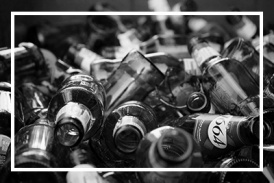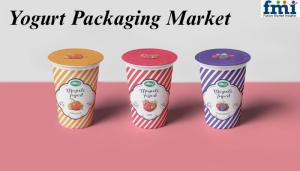Healthy Living and Smart Packaging to Propel Yogurt Packaging Market to USD 41,844.4 Million by 2035 | FMI
Japan’s yogurt packaging grow with demand for convenience, probiotic focus, and elderly nutrition, driving innovation in compact, clean, and shelf-smart design.
The global yogurt packaging market is undergoing a transformational shift as health-conscious consumers, sustainability-driven packaging innovations, and convenience-based purchasing trends converge. This growth is not merely a result of increasing yogurt consumption worldwide, but also a reflection of how packaging is evolving into a vital component of food marketing, preservation, and consumer experience.
Discover Growth Opportunities in the Market – Get Your Sample Report Now
https://www.futuremarketinsights.com/reports/sample/rep-gb-11825
Yogurt packaging refers to the containers, materials, and formats used to store and transport yogurt products safely from production facilities to consumer tables. This includes various types of plastic cups, glass jars, pouches, bottles, and multilayered paperboard cartons that are designed to maintain freshness, prevent contamination, and provide visual appeal on store shelves.
It’s not just about containment; yogurt packaging serves multiple purposes, from branding to convenience and sustainability. In today’s consumer-driven environment, packaging that combines functionality with minimal environmental impact has a strong edge.
Key Takeaways From the Yogurt Packaging Market
• The U.S. yogurt packaging market is projected to grow at a CAGR of 4.7% from 2025 to 2035, the highest among the listed countries.
• The UK market follows with a CAGR of 4.3%, slightly below the European Union’s regional average of 4.5%.
• Japan and South Korea are also emerging markets with projected CAGRs of 4.2% and 4.6%, respectively.
• In terms of packaging types, cups dominate the market, expected to hold a 39.4% share in 2025.
• Hypermarkets and supermarkets are the leading sales channel, projected to account for 46.7% of the market in 2025.
Rising Global Yogurt Consumption Drives Packaging Demand
One of the foundational growth drivers for yogurt packaging is the steady global rise in yogurt consumption. As consumers in both developed and emerging economies prioritize healthy diets, yogurt is being embraced for its probiotic content, nutritional value, and functional health benefits. With this increase in demand comes the need for high-quality, reliable, and innovative packaging solutions that can accommodate a diverse array of yogurt formats—ranging from drinkable yogurts and Greek yogurts to plant-based alternatives.
Developing countries, in particular, are witnessing a surge in yogurt adoption due to growing urbanization, rising disposable incomes, and increasing health awareness. This expanding yogurt consumer base propels packaging manufacturers to enhance their capacity and diversify their offerings.
Discover key market trends and unlock new growth avenues with our in-depth Packaging Formats Industry Analysis.
Sustainability Becomes a Core Design Imperative
Eco-consciousness is reshaping packaging standards across the food industry, and the yogurt sector is no exception. Sustainable packaging is becoming a competitive differentiator, not just an ethical responsibility. Consumers are actively seeking beands that reduce environmental impact, pushing manufacturers to explore recyclable, biodegradable, or reusable packaging alternatives.
Brands are replacing traditional plastic containers with bioplastics, paper-based tubs, and compostable films, while still maintaining food safety and quality. Lightweight packaging innovations also contribute to carbon footprint reduction during logistics. As regulatory frameworks tighten around single-use plastics and carbon emissions, yogurt packaging companies that integrate sustainability into their core product designs are likely to gain long-term market advantage.
Convenience and Functionality Shape Consumer Preferences
In a fast-paced lifestyle era, convenient and functional packaging drives purchasing decisions. Yogurt is often consumed on-the-go, especially in urban settings, which necessitates the need for user-friendly designs such as resealable lids, single-serve cups, squeeze pouches, and portable drinkable containers.
These formats not only provide practical usage but also enhance shelf appeal and encourage trial purchases. Packaging that offers ergonomic handling, mess-free consumption, and portion control supports consumers’ lifestyle needs and builds brand loyalty. Furthermore, innovative functional features—like spoon-in-lid solutions or dual-compartment packaging—enhance consumer experience and product differentiation.
Aesthetic Appeal and Branding Opportunities
In a crowded retail landscape, attractive packaging design serves as a silent salesperson. With yogurt being a frequently consumed item in daily diets, brands use packaging as a visual and emotional touchpoint to influence buying behavior. High-resolution printing, bold colors, creative shapes, and transparent windows help products stand out on shelves and communicate quality.
Competitive Landscape
The yogurt packaging market is moderately fragmented, with competition intensifying between global and regional packaging providers. Major players are:
• Amcor plc
• Berry Global Inc.
• Greiner Packaging International GmbH
• Huhtamaki Oyj
• Ecolean AB
• Sealed Air Corporation
• RPC Group (Berry Global)
• Constantia Flexibles Group GmbH
• Printpack, Inc.
• Mondi Group
• Winpak Ltd.
• Polyoak Packaging
Access Full Insights—Read More About This Report Now!
https://www.futuremarketinsights.com/reports/yogurt-packaging-market
Yogurt Packaging Market Segmentation
By Type of Packaging:
• Cups
• Molding Cups
• Pouches
o Squeeze Pouches
o Stand Up Pouches
• Containers
• Tetra Paks
• Aluminum Containers
• PET Jars and Bottles
• Opaque / Non-opaque Plastics Bags
• Bag in a Box
By Type of Yogurt:
• Dairy
• Vegan
By Basis of Sales Medium:
• B2B / Direct
• B2C / Indirect
o Hypermarket / Supermarket
o Convenience Stores
o Discount Stores
o Specialty Stores
o E-commerce, Online Retailers
o Traditional Groceries
By Region:
• North America
• Latin America
• Western Europe
• Eastern Europe
• East Asia
• South Asia Pacific
• Middle East and Africa
Have a Look at Related Research Reports on the Packaging Domain:
The zipper pouch market is likely to reach USD 2.35 billion in 2023 and is expected to surpass USD 3.90 billion by 2033, exhibiting a CAGR of 5.2% between 2023 and 2033. - https://www.futuremarketinsights.com/reports/zipper-pouch-market
The global layer pads market is projected to reach USD 1.5 billion in 2025 and is anticipated to grow at a CAGR of 5.6% to attain USD 2.5 billion by 2035. - https://www.futuremarketinsights.com/reports/layer-pads-market
The bag in tube market is anticipated to be worth USD 5.6 million in 2024. The market is projected to reach USD 8.7 million by 2034. - https://www.futuremarketinsights.com/reports/bag-in-tube-packaging-market
The global sales of passive temperature-controlled packaging solutions is estimated to be worth USD 13,865 million in 2024 and anticipated to reach a value of USD 28,137 million by 2034. - https://www.futuremarketinsights.com/reports/passive-temperature-controlled-packaging-solutions-market-092017
The temperature controlled pharmaceutical packaging solutions market had an estimated market share worth USD 4.6 billion in 2023, and it is predicted to reach a global market valuation of USD 7.7 billion by 2034, growing at a CAGR of 4.8% from 2024 to 2034. - https://www.futuremarketinsights.com/reports/temperature-controlled-pharmaceutical-packaging-solutions-market
About Future Market Insights (FMI)
Future Market Insights, Inc. (ESOMAR certified, recipient of the Stevie Award, and a member of the Greater New York Chamber of Commerce) offers profound insights into the driving factors that are boosting demand in the market. FMI stands as the leading global provider of market intelligence, advisory services, consulting, and events for the Packaging, Food and Beverage, Consumer, Technology, Healthcare, Industrial, and Chemicals markets. With a vast team of over 400 analysts worldwide, FMI provides global, regional, and local expertise on diverse domains and industry trends across more than 110 countries.
Join us as we commemorate 10 years of delivering trusted market insights. Reflecting on a decade of achievements, we continue to lead with integrity, innovation, and expertise.
Contact Us:
Future Market Insights Inc.
Christiana Corporate, 200 Continental Drive,
Suite 401, Newark, Delaware - 19713, USA
T: +1-347-918-3531
For Sales Enquiries: sales@futuremarketinsights.com
Website: https://www.futuremarketinsights.com
Ankush Nikam
Future Market Insights, Inc.
+ +91 90966 84197
email us here
Visit us on social media:
LinkedIn
Facebook
YouTube
X
Legal Disclaimer:
EIN Presswire provides this news content "as is" without warranty of any kind. We do not accept any responsibility or liability for the accuracy, content, images, videos, licenses, completeness, legality, or reliability of the information contained in this article. If you have any complaints or copyright issues related to this article, kindly contact the author above.
DAM Fashion by Deborah Ann Mack Announces Re-Grand Opening and Fall 2025 Coat Preview
Groundbreaking New Research Shows Osteoarthritis of the Back and Neck Can Be Reversed
Beverly Hills Cosmetic Dentist Kevin Sands, DDS Featured Among Top Cosmetic Dentists Nationwide
Więcej ważnych informacji
 Jedynka Newserii
Jedynka Newserii

 Jedynka Newserii
Jedynka Newserii

Handel

1 października ruszy w Polsce system kaucyjny. Część sieci handlowych może nie zdążyć z przygotowaniami przed tym terminem
Producenci, sklepy i operatorzy systemu kaucyjnego mają niespełna dwa miesiące na finalizację przygotowań do jego startu. Wówczas na rynku pojawią się napoje w specjalnie oznakowanych opakowaniach, a jednostki handlu powinny być gotowe na ich odbieranie. Część z nich jest już do tego przygotowana, część ostrzega przed ewentualnymi opóźnieniami. Jednym z ważniejszych aspektów przygotowań na te dwa miesiące jest uregulowanie współpracy między operatorami, których będzie siedmiu, co oznacza de facto siedem różnych systemów kaucyjnych.
Ochrona środowiska
KE proponuje nowy cel klimatyczny. Według europosłów wydaje się niemożliwy do realizacji

Komisja Europejska zaproponowała zmianę unijnego prawa o klimacie, wskazując nowy cel klimatyczny na 2040 roku, czyli redukcję emisji gazów cieplarnianych o 90 proc. w porównaniu do 1990 rok. Jesienią odniosą się do tego kraje członkowskie i Parlament Europejski, ale już dziś słychać wiele negatywnych głosów. Zdaniem polskich europarlamentarzystów już dotychczas ustanowione cele nie zostaną osiągnięte, a europejska gospodarka i jej konkurencyjność ucierpi na dążeniu do ich realizacji względem m.in. Stanów Zjednoczonych czy Chin.
Handel
Amerykańskie indeksy mają za sobą kolejny wzrostowy miesiąc. Druga połowa roku na rynkach akcji może być nerwowa

Lipiec zazwyczaj jest pozytywnym miesiącem na rynkach akcji i tegoroczny nie był wyjątkiem. Amerykańskie indeksy zakończyły go na plusie, podobnie jak większość europejskich. Rynki Starego Kontynentu nie przyciągają jednak już kapitału z taką intensywnością jak w pierwszej części roku. Z drugiej strony wyceny za oceanem po kolejnych rekordach są już bardzo wysokie, a wpływ nowego porządku celnego narzuconego przez Donalda Trumpa – na razie trudny do przewidzenia. W najbliższym czasie na rynkach można się spodziewać jeszcze większej zmienności i nerwowości, ale dopóki spółki pokazują dobre wyniki, przesłanek do zmiany trendu na spadkowy nie ma.
Partner serwisu
Szkolenia

Akademia Newserii
Akademia Newserii to projekt, w ramach którego najlepsi polscy dziennikarze biznesowi, giełdowi oraz lifestylowi, a także szkoleniowcy z wieloletnim doświadczeniem dzielą się swoją wiedzą nt. pracy z mediami.



![Nestlé w Polsce podsumowuje wpływ na krajową gospodarkę. Firma wygenerowała 0,6 proc. polskiego PKB [DEPESZA]](https://www.newseria.pl/files/1097841585/fabryka-nesquik_1,w_85,r_png,_small.png)




.gif)

 |
| |
| |
|